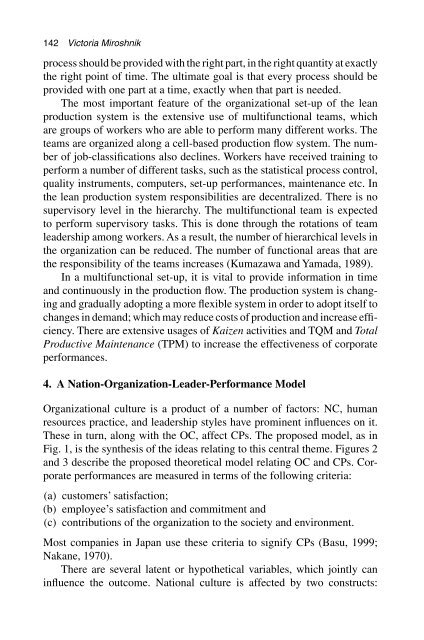Economic Models - Convex Optimization
Economic Models - Convex Optimization
Economic Models - Convex Optimization
You also want an ePaper? Increase the reach of your titles
YUMPU automatically turns print PDFs into web optimized ePapers that Google loves.
142 Victoria Miroshnik<br />
process should be provided with the right part, in the right quantity at exactly<br />
the right point of time. The ultimate goal is that every process should be<br />
provided with one part at a time, exactly when that part is needed.<br />
The most important feature of the organizational set-up of the lean<br />
production system is the extensive use of multifunctional teams, which<br />
are groups of workers who are able to perform many different works. The<br />
teams are organized along a cell-based production flow system. The number<br />
of job-classifications also declines. Workers have received training to<br />
perform a number of different tasks, such as the statistical process control,<br />
quality instruments, computers, set-up performances, maintenance etc. In<br />
the lean production system responsibilities are decentralized. There is no<br />
supervisory level in the hierarchy. The multifunctional team is expected<br />
to perform supervisory tasks. This is done through the rotations of team<br />
leadership among workers. As a result, the number of hierarchical levels in<br />
the organization can be reduced. The number of functional areas that are<br />
the responsibility of the teams increases (Kumazawa and Yamada, 1989).<br />
In a multifunctional set-up, it is vital to provide information in time<br />
and continuously in the production flow. The production system is changing<br />
and gradually adopting a more flexible system in order to adopt itself to<br />
changes in demand; which may reduce costs of production and increase efficiency.<br />
There are extensive usages of Kaizen activities and TQM and Total<br />
Productive Maintenance (TPM) to increase the effectiveness of corporate<br />
performances.<br />
4. A Nation-Organization-Leader-Performance Model<br />
Organizational culture is a product of a number of factors: NC, human<br />
resources practice, and leadership styles have prominent influences on it.<br />
These in turn, along with the OC, affect CPs. The proposed model, as in<br />
Fig. 1, is the synthesis of the ideas relating to this central theme. Figures 2<br />
and 3 describe the proposed theoretical model relating OC and CPs. Corporate<br />
performances are measured in terms of the following criteria:<br />
(a) customers’ satisfaction;<br />
(b) employee’s satisfaction and commitment and<br />
(c) contributions of the organization to the society and environment.<br />
Most companies in Japan use these criteria to signify CPs (Basu, 1999;<br />
Nakane, 1970).<br />
There are several latent or hypothetical variables, which jointly can<br />
influence the outcome. National culture is affected by two constructs:
















